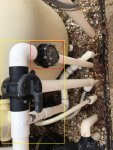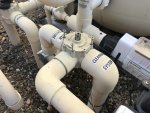Sorry for the odd title, been mulling it for 10 minutes now and can't figure out how to be most descriptive. So here's the story:
Bought the house almost two years ago, this winter I was stupid and didn't leave one of the manual valves open to a return line and the check valve body busted (bottom side of the red box below). The previous owner must have just had these lines replaced when I moved in, but he left me zero room to remove that check valve without taking out the entire "yellow box" area...as far as I can tell. Are there any pool/plumbing tricks to not having to rip it all out, which would mean not just a new check valve but also a new 3-port? The check valve butts right to the 90 on top which goes right into the 3-port which on its left goes right into something I still don't know what it is (gray threaded piece, may be freeze/pressure guard??).

Second question, is that check valve placed that high for a reason? That is a return I believe to the spa eyeballs, on the opposite side (to the left) is a return to the spa floor which has a check valve at the same height.
Bought the house almost two years ago, this winter I was stupid and didn't leave one of the manual valves open to a return line and the check valve body busted (bottom side of the red box below). The previous owner must have just had these lines replaced when I moved in, but he left me zero room to remove that check valve without taking out the entire "yellow box" area...as far as I can tell. Are there any pool/plumbing tricks to not having to rip it all out, which would mean not just a new check valve but also a new 3-port? The check valve butts right to the 90 on top which goes right into the 3-port which on its left goes right into something I still don't know what it is (gray threaded piece, may be freeze/pressure guard??).

Second question, is that check valve placed that high for a reason? That is a return I believe to the spa eyeballs, on the opposite side (to the left) is a return to the spa floor which has a check valve at the same height.


